Wind Speed Data Analysis and Forecasting
VerifiedAdded on 2021/02/22
|10
|1523
|322
AI Summary
The assignment provides a detailed analysis of wind speed data, including calculations of mean, median, mode, standard deviation, and range. The study concludes that data analysis plays a crucial role in making decisions related to forecasting. Theoretical information is provided at the end of the results after quantitative analysis.
Contribute Materials
Your contribution can guide someone’s learning journey. Share your
documents today.

PROJECT
Secure Best Marks with AI Grader
Need help grading? Try our AI Grader for instant feedback on your assignments.
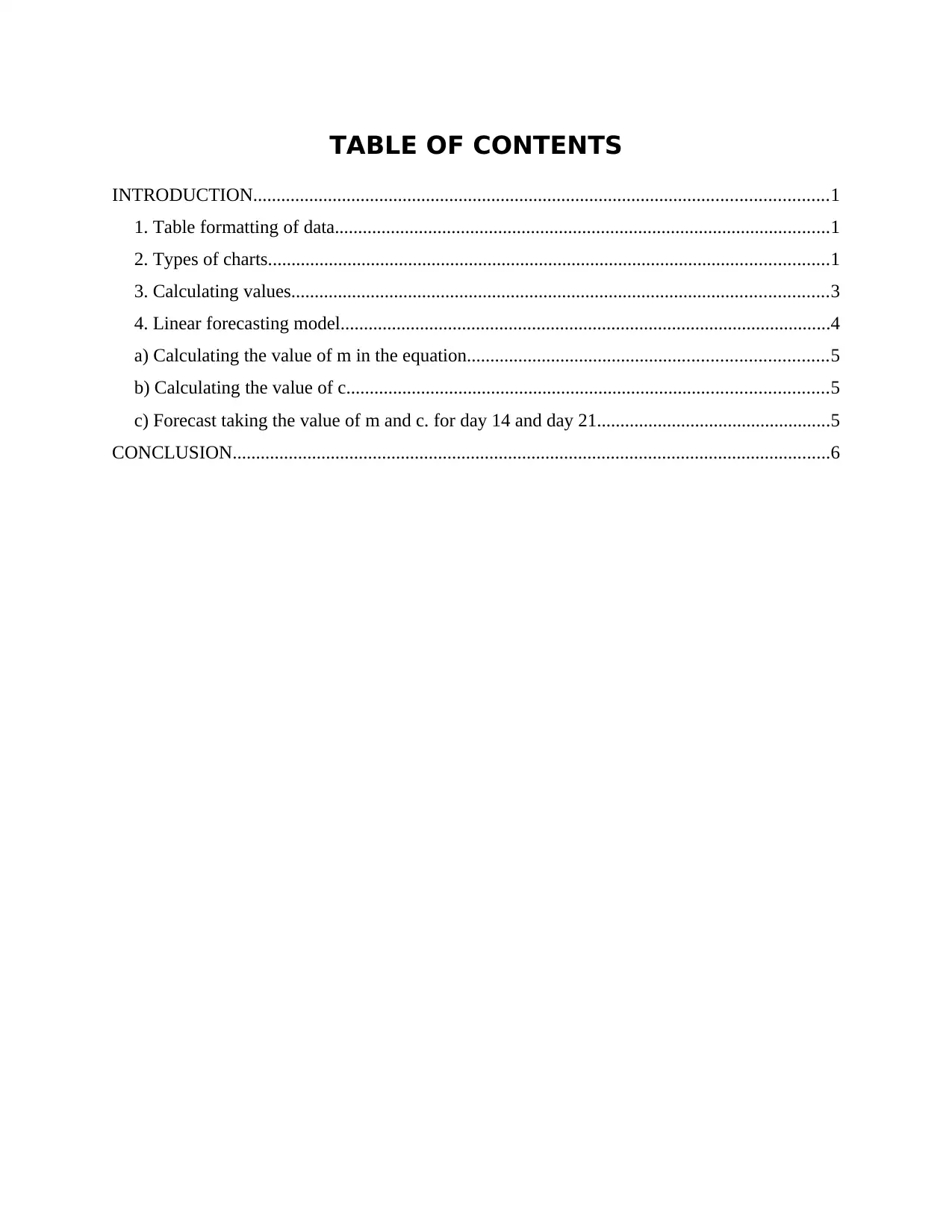
TABLE OF CONTENTS
INTRODUCTION...........................................................................................................................1
1. Table formatting of data..........................................................................................................1
2. Types of charts........................................................................................................................1
3. Calculating values...................................................................................................................3
4. Linear forecasting model.........................................................................................................4
a) Calculating the value of m in the equation.............................................................................5
b) Calculating the value of c.......................................................................................................5
c) Forecast taking the value of m and c. for day 14 and day 21..................................................5
CONCLUSION................................................................................................................................6
INTRODUCTION...........................................................................................................................1
1. Table formatting of data..........................................................................................................1
2. Types of charts........................................................................................................................1
3. Calculating values...................................................................................................................3
4. Linear forecasting model.........................................................................................................4
a) Calculating the value of m in the equation.............................................................................5
b) Calculating the value of c.......................................................................................................5
c) Forecast taking the value of m and c. for day 14 and day 21..................................................5
CONCLUSION................................................................................................................................6
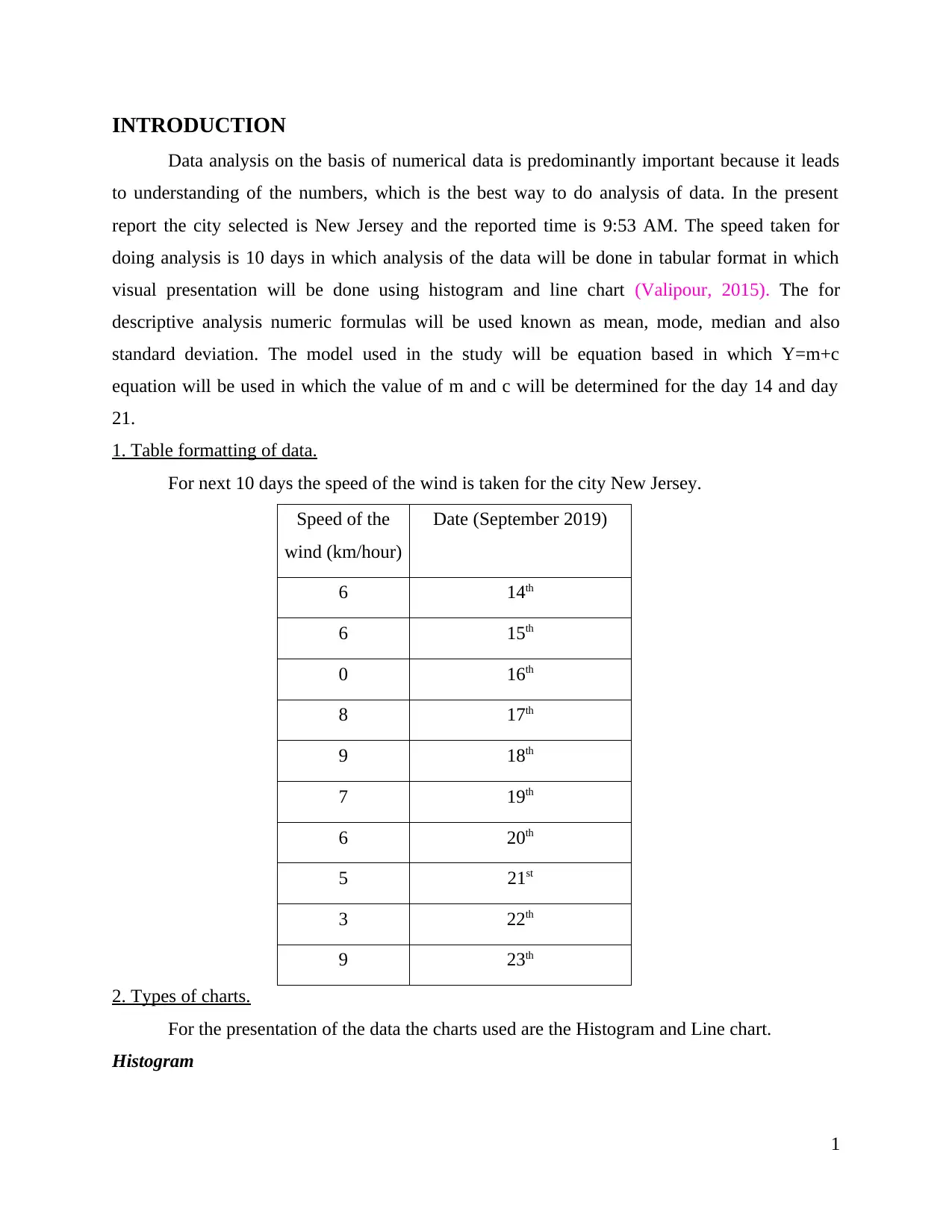
INTRODUCTION
Data analysis on the basis of numerical data is predominantly important because it leads
to understanding of the numbers, which is the best way to do analysis of data. In the present
report the city selected is New Jersey and the reported time is 9:53 AM. The speed taken for
doing analysis is 10 days in which analysis of the data will be done in tabular format in which
visual presentation will be done using histogram and line chart (Valipour, 2015). The for
descriptive analysis numeric formulas will be used known as mean, mode, median and also
standard deviation. The model used in the study will be equation based in which Y=m+c
equation will be used in which the value of m and c will be determined for the day 14 and day
21.
1. Table formatting of data.
For next 10 days the speed of the wind is taken for the city New Jersey.
Speed of the
wind (km/hour)
Date (September 2019)
6 14th
6 15th
0 16th
8 17th
9 18th
7 19th
6 20th
5 21st
3 22th
9 23th
2. Types of charts.
For the presentation of the data the charts used are the Histogram and Line chart.
Histogram
1
Data analysis on the basis of numerical data is predominantly important because it leads
to understanding of the numbers, which is the best way to do analysis of data. In the present
report the city selected is New Jersey and the reported time is 9:53 AM. The speed taken for
doing analysis is 10 days in which analysis of the data will be done in tabular format in which
visual presentation will be done using histogram and line chart (Valipour, 2015). The for
descriptive analysis numeric formulas will be used known as mean, mode, median and also
standard deviation. The model used in the study will be equation based in which Y=m+c
equation will be used in which the value of m and c will be determined for the day 14 and day
21.
1. Table formatting of data.
For next 10 days the speed of the wind is taken for the city New Jersey.
Speed of the
wind (km/hour)
Date (September 2019)
6 14th
6 15th
0 16th
8 17th
9 18th
7 19th
6 20th
5 21st
3 22th
9 23th
2. Types of charts.
For the presentation of the data the charts used are the Histogram and Line chart.
Histogram
1
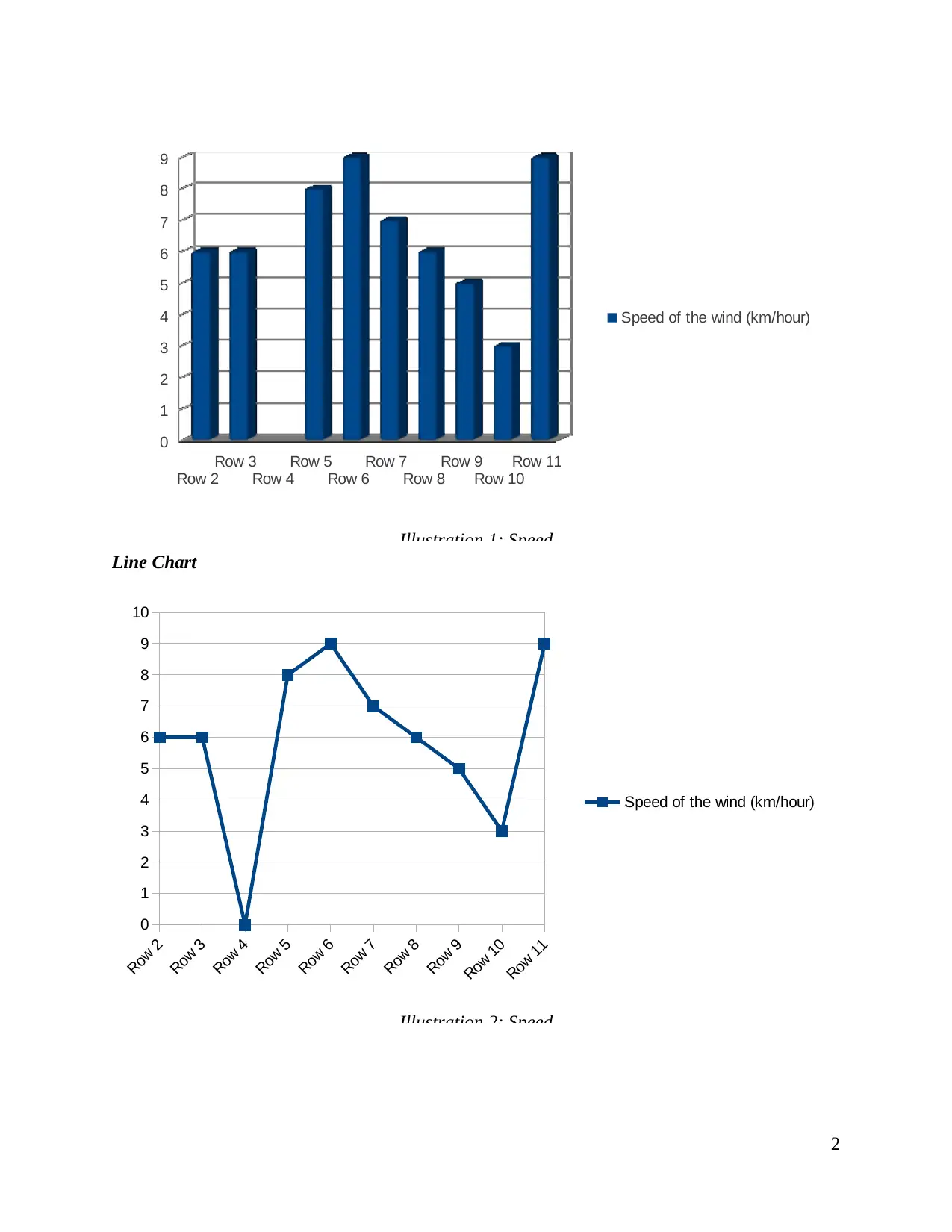
Line Chart
2
Row 2
Row 3
Row 4
Row 5
Row 6
Row 7
Row 8
Row 9
Row 10
Row 11
0
1
2
3
4
5
6
7
8
9
Speed of the wind (km/hour)
Illustration 1: Speed
Row 2
Row 3
Row 4
Row 5
Row 6
Row 7
Row 8
Row 9
Row 10
Row 11
0
1
2
3
4
5
6
7
8
9
10
Speed of the wind (km/hour)
Illustration 2: Speed
2
Row 2
Row 3
Row 4
Row 5
Row 6
Row 7
Row 8
Row 9
Row 10
Row 11
0
1
2
3
4
5
6
7
8
9
Speed of the wind (km/hour)
Illustration 1: Speed
Row 2
Row 3
Row 4
Row 5
Row 6
Row 7
Row 8
Row 9
Row 10
Row 11
0
1
2
3
4
5
6
7
8
9
10
Speed of the wind (km/hour)
Illustration 2: Speed
Secure Best Marks with AI Grader
Need help grading? Try our AI Grader for instant feedback on your assignments.
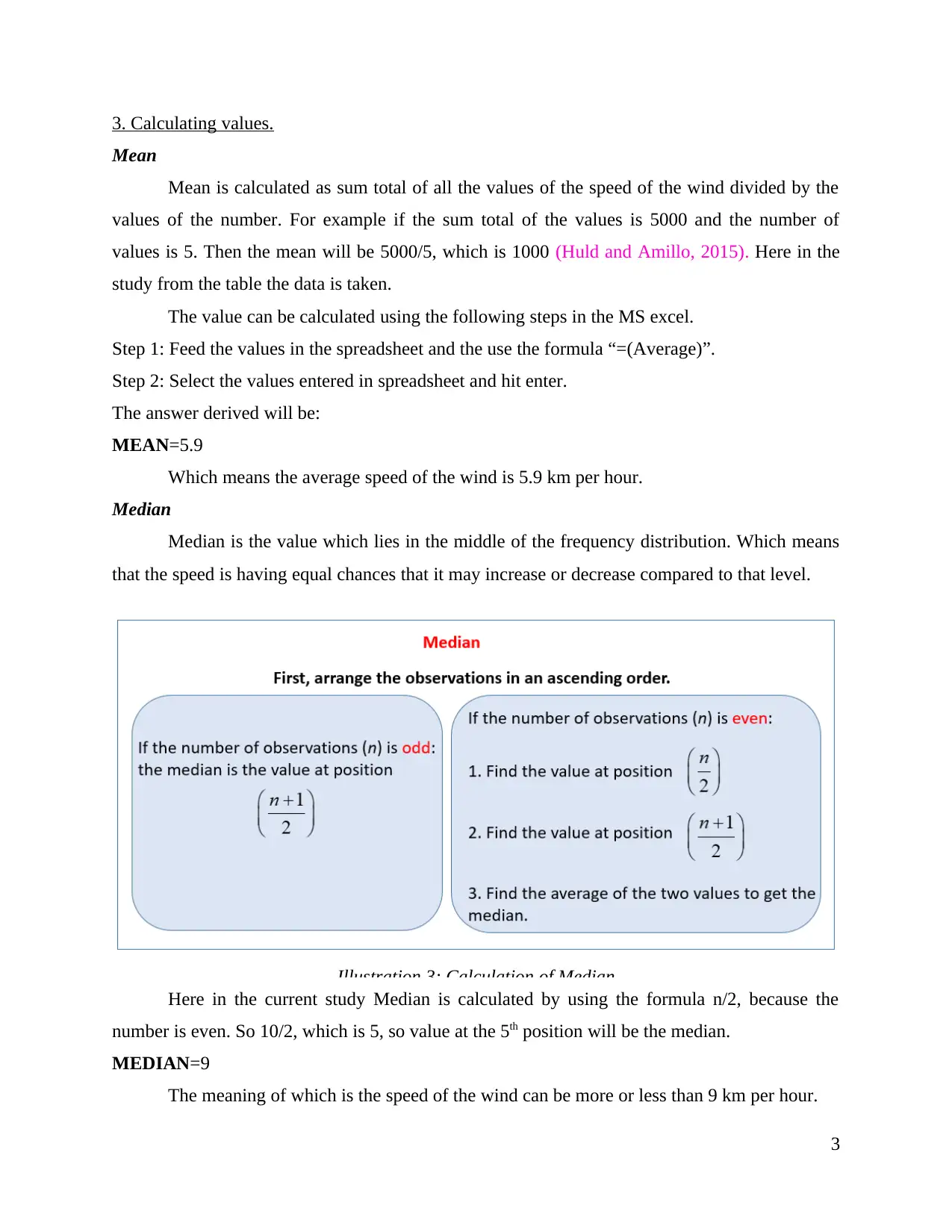
3. Calculating values.
Mean
Mean is calculated as sum total of all the values of the speed of the wind divided by the
values of the number. For example if the sum total of the values is 5000 and the number of
values is 5. Then the mean will be 5000/5, which is 1000 (Huld and Amillo, 2015). Here in the
study from the table the data is taken.
The value can be calculated using the following steps in the MS excel.
Step 1: Feed the values in the spreadsheet and the use the formula “=(Average)”.
Step 2: Select the values entered in spreadsheet and hit enter.
The answer derived will be:
MEAN=5.9
Which means the average speed of the wind is 5.9 km per hour.
Median
Median is the value which lies in the middle of the frequency distribution. Which means
that the speed is having equal chances that it may increase or decrease compared to that level.
Here in the current study Median is calculated by using the formula n/2, because the
number is even. So 10/2, which is 5, so value at the 5th position will be the median.
MEDIAN=9
The meaning of which is the speed of the wind can be more or less than 9 km per hour.
3
Illustration 3: Calculation of Median
Mean
Mean is calculated as sum total of all the values of the speed of the wind divided by the
values of the number. For example if the sum total of the values is 5000 and the number of
values is 5. Then the mean will be 5000/5, which is 1000 (Huld and Amillo, 2015). Here in the
study from the table the data is taken.
The value can be calculated using the following steps in the MS excel.
Step 1: Feed the values in the spreadsheet and the use the formula “=(Average)”.
Step 2: Select the values entered in spreadsheet and hit enter.
The answer derived will be:
MEAN=5.9
Which means the average speed of the wind is 5.9 km per hour.
Median
Median is the value which lies in the middle of the frequency distribution. Which means
that the speed is having equal chances that it may increase or decrease compared to that level.
Here in the current study Median is calculated by using the formula n/2, because the
number is even. So 10/2, which is 5, so value at the 5th position will be the median.
MEDIAN=9
The meaning of which is the speed of the wind can be more or less than 9 km per hour.
3
Illustration 3: Calculation of Median
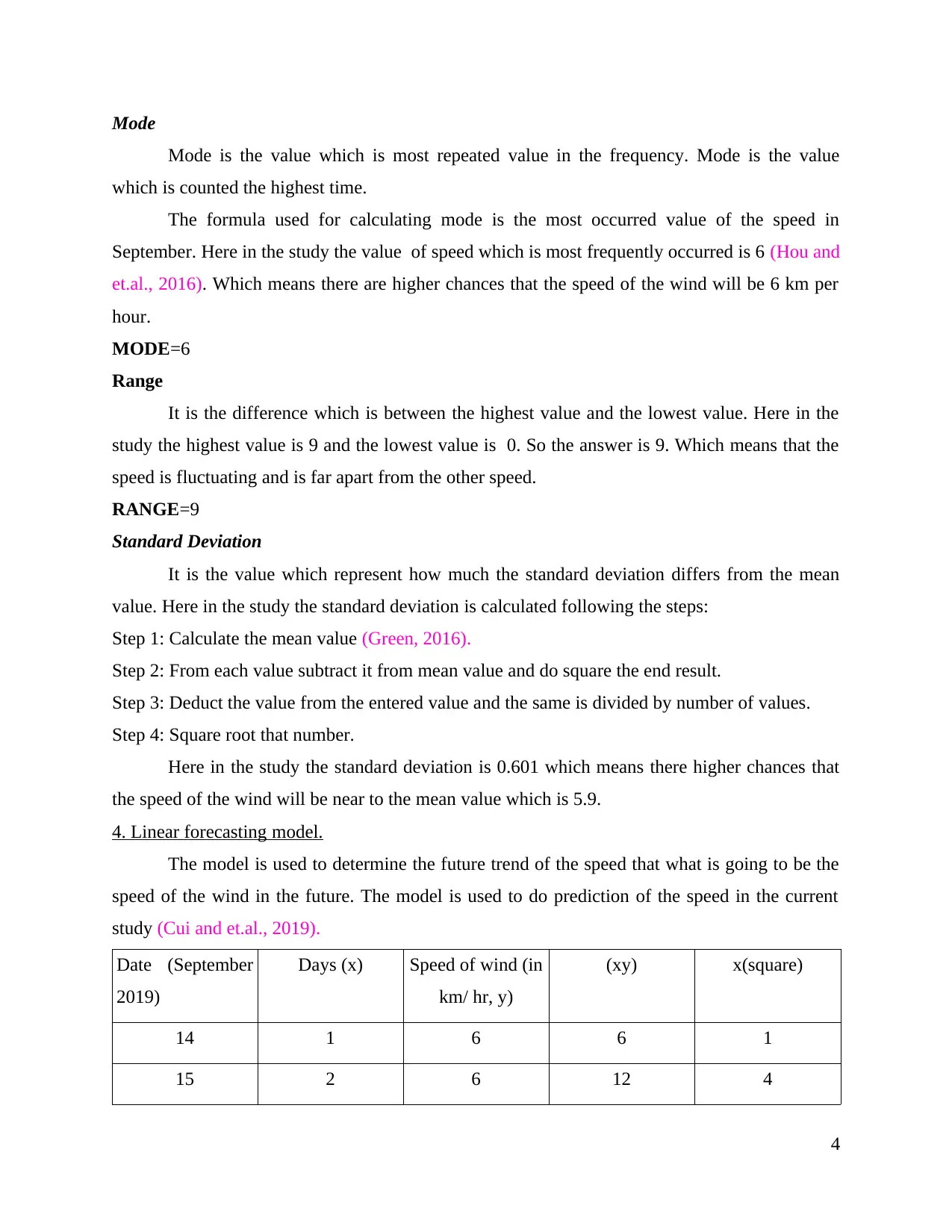
Mode
Mode is the value which is most repeated value in the frequency. Mode is the value
which is counted the highest time.
The formula used for calculating mode is the most occurred value of the speed in
September. Here in the study the value of speed which is most frequently occurred is 6 (Hou and
et.al., 2016). Which means there are higher chances that the speed of the wind will be 6 km per
hour.
MODE=6
Range
It is the difference which is between the highest value and the lowest value. Here in the
study the highest value is 9 and the lowest value is 0. So the answer is 9. Which means that the
speed is fluctuating and is far apart from the other speed.
RANGE=9
Standard Deviation
It is the value which represent how much the standard deviation differs from the mean
value. Here in the study the standard deviation is calculated following the steps:
Step 1: Calculate the mean value (Green, 2016).
Step 2: From each value subtract it from mean value and do square the end result.
Step 3: Deduct the value from the entered value and the same is divided by number of values.
Step 4: Square root that number.
Here in the study the standard deviation is 0.601 which means there higher chances that
the speed of the wind will be near to the mean value which is 5.9.
4. Linear forecasting model.
The model is used to determine the future trend of the speed that what is going to be the
speed of the wind in the future. The model is used to do prediction of the speed in the current
study (Cui and et.al., 2019).
Date (September
2019)
Days (x) Speed of wind (in
km/ hr, y)
(xy) x(square)
14 1 6 6 1
15 2 6 12 4
4
Mode is the value which is most repeated value in the frequency. Mode is the value
which is counted the highest time.
The formula used for calculating mode is the most occurred value of the speed in
September. Here in the study the value of speed which is most frequently occurred is 6 (Hou and
et.al., 2016). Which means there are higher chances that the speed of the wind will be 6 km per
hour.
MODE=6
Range
It is the difference which is between the highest value and the lowest value. Here in the
study the highest value is 9 and the lowest value is 0. So the answer is 9. Which means that the
speed is fluctuating and is far apart from the other speed.
RANGE=9
Standard Deviation
It is the value which represent how much the standard deviation differs from the mean
value. Here in the study the standard deviation is calculated following the steps:
Step 1: Calculate the mean value (Green, 2016).
Step 2: From each value subtract it from mean value and do square the end result.
Step 3: Deduct the value from the entered value and the same is divided by number of values.
Step 4: Square root that number.
Here in the study the standard deviation is 0.601 which means there higher chances that
the speed of the wind will be near to the mean value which is 5.9.
4. Linear forecasting model.
The model is used to determine the future trend of the speed that what is going to be the
speed of the wind in the future. The model is used to do prediction of the speed in the current
study (Cui and et.al., 2019).
Date (September
2019)
Days (x) Speed of wind (in
km/ hr, y)
(xy) x(square)
14 1 6 6 1
15 2 6 12 4
4
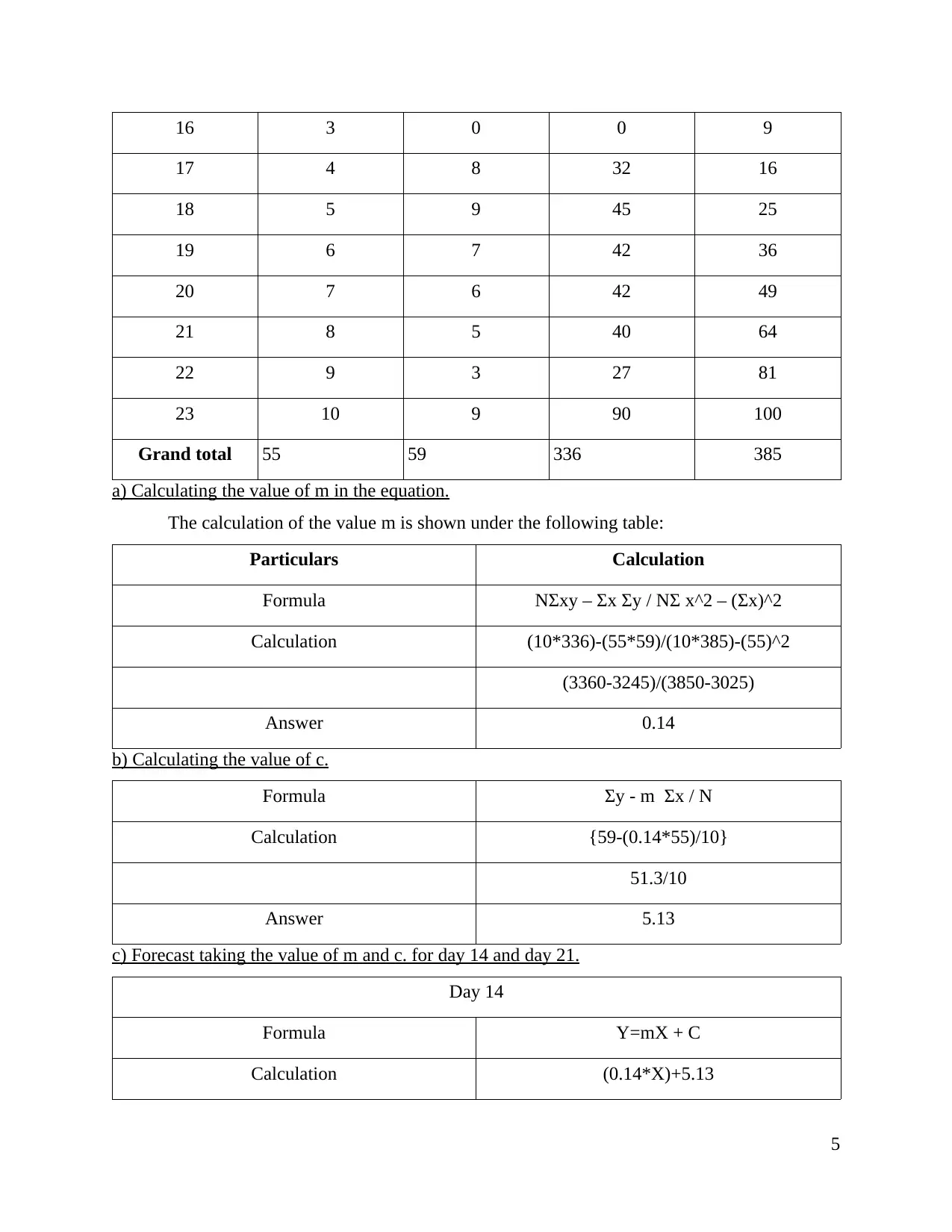
16 3 0 0 9
17 4 8 32 16
18 5 9 45 25
19 6 7 42 36
20 7 6 42 49
21 8 5 40 64
22 9 3 27 81
23 10 9 90 100
Grand total 55 59 336 385
a) Calculating the value of m in the equation.
The calculation of the value m is shown under the following table:
Particulars Calculation
Formula NΣxy – Σx Σy / NΣ x^2 – (Σx)^2
Calculation (10*336)-(55*59)/(10*385)-(55)^2
(3360-3245)/(3850-3025)
Answer 0.14
b) Calculating the value of c.
Formula Σy - m Σx / N
Calculation {59-(0.14*55)/10}
51.3/10
Answer 5.13
c) Forecast taking the value of m and c. for day 14 and day 21.
Day 14
Formula Y=mX + C
Calculation (0.14*X)+5.13
5
17 4 8 32 16
18 5 9 45 25
19 6 7 42 36
20 7 6 42 49
21 8 5 40 64
22 9 3 27 81
23 10 9 90 100
Grand total 55 59 336 385
a) Calculating the value of m in the equation.
The calculation of the value m is shown under the following table:
Particulars Calculation
Formula NΣxy – Σx Σy / NΣ x^2 – (Σx)^2
Calculation (10*336)-(55*59)/(10*385)-(55)^2
(3360-3245)/(3850-3025)
Answer 0.14
b) Calculating the value of c.
Formula Σy - m Σx / N
Calculation {59-(0.14*55)/10}
51.3/10
Answer 5.13
c) Forecast taking the value of m and c. for day 14 and day 21.
Day 14
Formula Y=mX + C
Calculation (0.14*X)+5.13
5
Paraphrase This Document
Need a fresh take? Get an instant paraphrase of this document with our AI Paraphraser
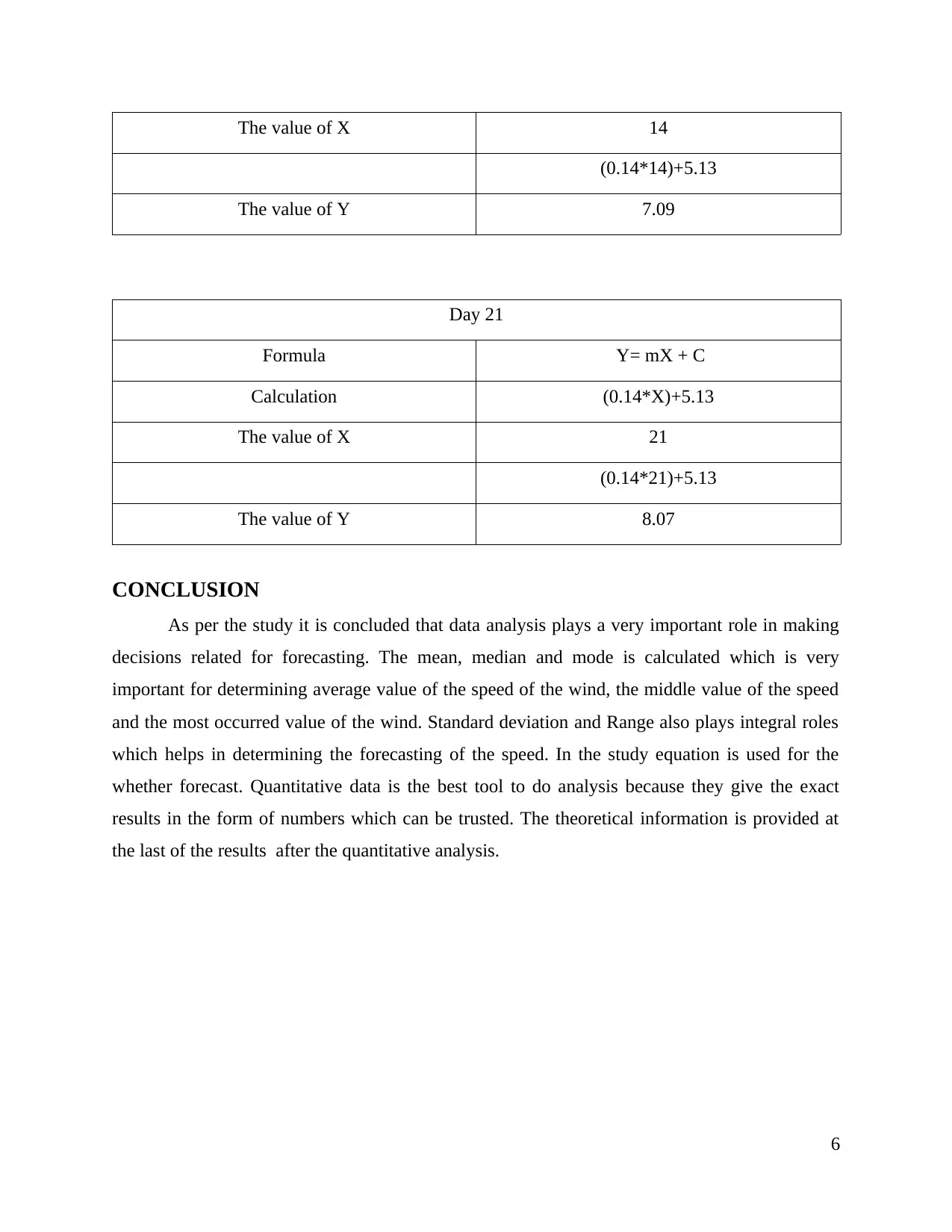
The value of X 14
(0.14*14)+5.13
The value of Y 7.09
Day 21
Formula Y= mX + C
Calculation (0.14*X)+5.13
The value of X 21
(0.14*21)+5.13
The value of Y 8.07
CONCLUSION
As per the study it is concluded that data analysis plays a very important role in making
decisions related for forecasting. The mean, median and mode is calculated which is very
important for determining average value of the speed of the wind, the middle value of the speed
and the most occurred value of the wind. Standard deviation and Range also plays integral roles
which helps in determining the forecasting of the speed. In the study equation is used for the
whether forecast. Quantitative data is the best tool to do analysis because they give the exact
results in the form of numbers which can be trusted. The theoretical information is provided at
the last of the results after the quantitative analysis.
6
(0.14*14)+5.13
The value of Y 7.09
Day 21
Formula Y= mX + C
Calculation (0.14*X)+5.13
The value of X 21
(0.14*21)+5.13
The value of Y 8.07
CONCLUSION
As per the study it is concluded that data analysis plays a very important role in making
decisions related for forecasting. The mean, median and mode is calculated which is very
important for determining average value of the speed of the wind, the middle value of the speed
and the most occurred value of the wind. Standard deviation and Range also plays integral roles
which helps in determining the forecasting of the speed. In the study equation is used for the
whether forecast. Quantitative data is the best tool to do analysis because they give the exact
results in the form of numbers which can be trusted. The theoretical information is provided at
the last of the results after the quantitative analysis.
6
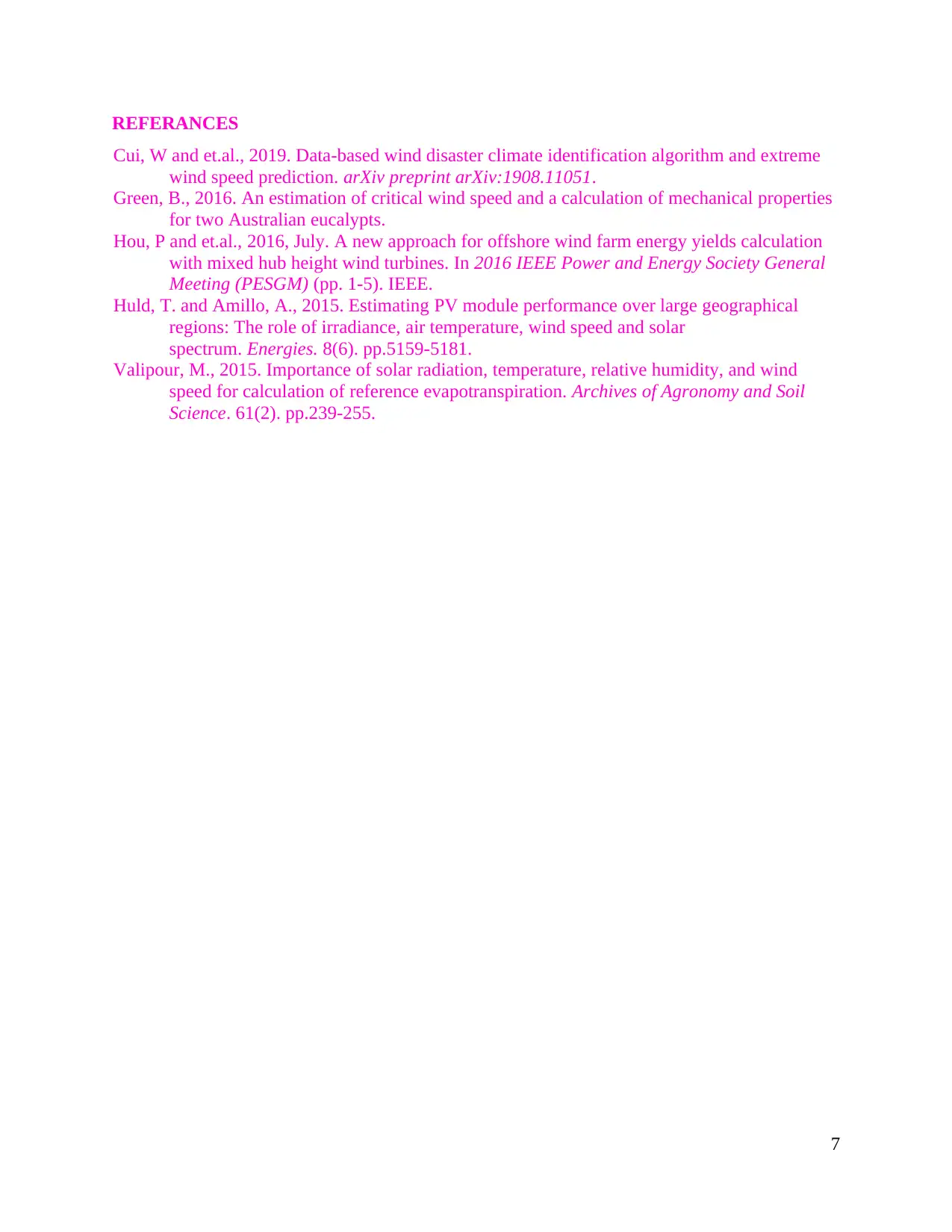
REFERANCES
Cui, W and et.al., 2019. Data-based wind disaster climate identification algorithm and extreme
wind speed prediction. arXiv preprint arXiv:1908.11051.
Green, B., 2016. An estimation of critical wind speed and a calculation of mechanical properties
for two Australian eucalypts.
Hou, P and et.al., 2016, July. A new approach for offshore wind farm energy yields calculation
with mixed hub height wind turbines. In 2016 IEEE Power and Energy Society General
Meeting (PESGM) (pp. 1-5). IEEE.
Huld, T. and Amillo, A., 2015. Estimating PV module performance over large geographical
regions: The role of irradiance, air temperature, wind speed and solar
spectrum. Energies. 8(6). pp.5159-5181.
Valipour, M., 2015. Importance of solar radiation, temperature, relative humidity, and wind
speed for calculation of reference evapotranspiration. Archives of Agronomy and Soil
Science. 61(2). pp.239-255.
7
Cui, W and et.al., 2019. Data-based wind disaster climate identification algorithm and extreme
wind speed prediction. arXiv preprint arXiv:1908.11051.
Green, B., 2016. An estimation of critical wind speed and a calculation of mechanical properties
for two Australian eucalypts.
Hou, P and et.al., 2016, July. A new approach for offshore wind farm energy yields calculation
with mixed hub height wind turbines. In 2016 IEEE Power and Energy Society General
Meeting (PESGM) (pp. 1-5). IEEE.
Huld, T. and Amillo, A., 2015. Estimating PV module performance over large geographical
regions: The role of irradiance, air temperature, wind speed and solar
spectrum. Energies. 8(6). pp.5159-5181.
Valipour, M., 2015. Importance of solar radiation, temperature, relative humidity, and wind
speed for calculation of reference evapotranspiration. Archives of Agronomy and Soil
Science. 61(2). pp.239-255.
7

8
1 out of 10
Related Documents
Your All-in-One AI-Powered Toolkit for Academic Success.
+13062052269
info@desklib.com
Available 24*7 on WhatsApp / Email
![[object Object]](/_next/static/media/star-bottom.7253800d.svg)
Unlock your academic potential
© 2024 | Zucol Services PVT LTD | All rights reserved.





